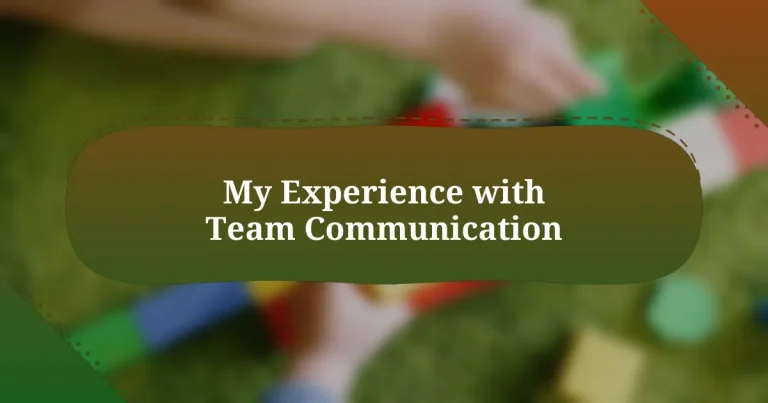Key takeaways:
- Effective communication, including verbal and non-verbal cues, is crucial for teamwork and success in cricket.
- Active listening fosters stronger bonds among young players, allowing them to feel valued and respected.
- Open dialogue and structured team talks lead to trust and innovative strategies that improve performance.
- Recognizing individual contributions and shared experiences helps build confidence and lasting relationships within the team.
Understanding team communication in cricket
Effective team communication in cricket is essential for success on the field. During my early days playing for my school team, I vividly remember a match where a miscommunication led to a run-out that could have been easily avoided. It made me realize how vital it is for teammates to be clear and vocal about their intentions, whether it’s calling for a run or strategizing in the field.
I often found that body language played a pivotal role in our interactions as well. For instance, I noticed how a simple nod or a thumbs-up between bowlers can provide immense confidence, especially in pressure situations. Have you ever had a teammate who inspired you with just a gesture? Those non-verbal cues can often speak louder than words, creating an unspoken bond that enhances overall team dynamics.
Furthermore, I believe regular huddles and discussions are crucial. After a tough loss, our coach encouraged us to share our thoughts and feelings about the game. This not only fostered open communication but also helped us learn from each other. Do you think discussing failures can actually strengthen team relationships? From my experience, confronting challenges together often brings players closer, making them more resilient as a unit.
Importance of communication in sports
Effective communication in sports goes beyond just talking; it’s the lifeline of any successful team. I remember during a particularly tense final match, we used hand signals to signify play adjustments without alerting the opposing team. This strategy not only enhanced our effectiveness on the field but also unified us as a squad. Have you ever found yourself in a situation where a silent cue changed the game for you?
The emotional aspect of communication cannot be overlooked either. I once played with a teammate who had a unique way of reassuring others. Just before facing a tough bowler, he would lean in and say, “We’ve got this.” Those words made a world of difference, boosting our confidence when it mattered most. The power of a few well-chosen words can lift spirits and forge a stronger connection. Isn’t it fascinating how something so simple can create a shared sense of resolve?
Moreover, fostering an open dialogue about strategies before and after matches creates a culture of trust. In one memorable training session, we brainstormed our tactics openly, and it sparked innovative ideas that led to a winning match strategy later. I’ve found that when everyone feels heard, it elevates the team’s overall performance. How do you think open discussions can shape a team’s future? In my experience, that shared vision ignites a fire in the players, propelling them to achieve their best together.
Key communication skills for kids
One of the key communication skills for kids is active listening. I remember a team huddle where we discussed each player’s concerns before a big game. Listening attentively not only showed respect for each other but also built a stronger bond. When kids feel heard, they’re more likely to share their thoughts openly, leading to a more cohesive team. Have you noticed how much more engaged kids become when they know their voices matter?
Another essential skill is expressing thoughts clearly. During my junior cricket days, we often had to convey plays quickly under pressure. I learned that simple, direct language cut through the chaos, helping my teammates understand the plan without confusion. It’s fascinating how clarity in communication can be the difference between confusion and success, right? Encouraging kids to practice clear articulation can help them gain confidence on and off the field.
Non-verbal communication also plays a significant role in a team’s synergy. There were moments during matches when a simple nod or a smile from a teammate made all the difference— it was like a silent agreement that we were on the same page. I believe teaching kids to read body language equips them to gauge their teammates’ moods and intentions more effectively. How valuable do you think it is for kids to become aware of these subtle cues during gameplay?
Techniques for effective team talks
One effective technique for team talks is to encourage open dialogue. I remember a particularly intense squad meeting where we gathered in a circle. Each player was invited to share their thoughts, and I noticed how a safe space led to unexpected insights. It was amazing to see how one player’s concern about our fielding strategy sparked a solution that I had not considered. Have you ever experienced that exhilarating moment when a simple conversation brings everyone together?
Another valuable approach is to set a clear agenda for each team talk. In my experience, having a focused discussion reduces distractions and ensures that everyone knows what to expect. Before matches, we’d often list key points to cover, such as strategy and personal roles, which kept us all grounded. It’s like preparing for a crucial exam—don’t you find that structure makes you feel more prepared and confident?
Incorporating fun elements into team talks can also break the ice and lighten the mood. During one memorable huddle, we shared our personal ‘superstitions’ about pre-game rituals. This not only entertained us but also nurtured camaraderie amongst teammates. I think it’s fascinating how humor can create connections, making kids feel more comfortable and open during discussions. What fun techniques do you think could work to keep the atmosphere light while still being productive?
Building trust among young players
Building trust among young players hinges on creating an environment where they feel valued and respected. One day, during practice, I noticed a group of younger teammates hesitating to voice their mistakes. I decided to share my own blunders from when I was their age, and their faces shifted from apprehension to understanding. This moment reminded me that vulnerability fosters trust; when players see that everyone makes mistakes, they’re more likely to support one another.
Another essential aspect is recognition of each player’s contributions, no matter how small. After one match, I made it a point to highlight how even the quietest player saved us runs by making a smart play. Their smile lit up the room, and it was clear that acknowledging effort builds confidence. What does it feel like to receive praise from your peers? In these moments, I learned firsthand how cultivating a culture of appreciation strengthens team bonds.
Finally, encouraging teamwork through collaborative activities can help break down barriers among young players. I remember organizing a fun drill where pairs had to rely on one another to complete a task. The laughter and friendly competition established connections that weren’t there before. Don’t you think that shared experiences can cement trust and create lasting friendships within the team?
Lessons learned from team communication
Communication within a team has taught me the importance of clarity and consistency. I vividly remember a match where we all seemed to be on different wavelengths; some players were calling for the ball, while others hesitated, leading to a missed catch. Reflecting on that moment, I realized that open dialogue helps prevent confusion and ensures everyone is on the same page. How can we expect to perform as a cohesive unit if we’re not communicating effectively?
Another critical lesson involves active listening. During a team meeting, one younger player shared a strategy that initially seemed unorthodox. I made the effort to really listen, and in doing so, I learned that sometimes fresh perspectives can fuel our game. Have you ever found yourself surprised by a teammate’s idea? That day, I grasped that giving everyone a voice not only empowers individuals but can also lead to unexpected breakthroughs in our performance.
Lastly, I’ve learned that feedback is a two-way street. After a game, I had a conversation with a player who expressed how my playing style impacted their confidence. It was a revelation for both of us; I realized that my actions could either elevate or diminish someone else’s experience. Have you ever shared how someone influenced your game? This exchange taught me that being open to feedback creates a supportive atmosphere where players feel safe to grow and improve together.



